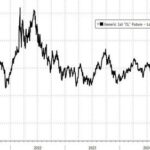
Eli Lilly Soars While UnitedHealth Struggles: Stock Insights for April 17, 2025
Tháng 4 17, 2025
Jerome Powell’s Cautious Outlook: Navigating Economic Uncertainty in 2025
Tháng 4 17, 2025Sentiment Shift Analysis: Current Traders’ Positioning
Trader Sentiment Metrics: 72% Short Positions Indicate Fear
An analysis of the current market sentiment reveals that a striking 72% of traders are holding short positions in the USDCAD currency pair. This significant majority underscores a prevailing atmosphere of fear among market participants. Such high short positioning typically suggests that traders anticipate further declines in the Canadian dollar relative to the U.S. dollar—likely spurred by recent economic data, geopolitical tensions, or expectations surrounding monetary policy decisions.
Understanding that this level of short interest reflects a collective belief in a bearish trend is crucial. Fear-driven sentiment can amplify market movements, leading to increased volatility as traders react to new information and prevailing market psychology. When so many participants take a bearish stance, it creates a self-fulfilling prophecy where selling pressure builds, often pushing prices down further.
However, it is important to recognize that extreme levels of bearish sentiment can also set the stage for potential market corrections. The adage “the market climbs a wall of worry” holds true here; as fear escalates, any sign of optimism or contrary data can trigger rapid price reversals, making it essential for traders to remain vigilant and receptive to shifts in market sentiment.
Correlation Between Sentiment and Price Action: Limited Data
While sentiment analysis plays a vital role in predicting market movements, the current climate presents challenges in establishing a clear correlation between sentiment and price action due to limited data. Historical trends can provide some guidance; however, when sentiment is overwhelmingly skewed, the typical market dynamics may behave unpredictably.
Currently, the high level of short positioning indicates a strong bearish sentiment, but without accompanying price movement data or context, making predictions becomes complex. For instance, if the price stagnates or experiences only minor fluctuations, it could reflect that the market is absorbing the existing fear rather than allowing it to dictate drastic price changes. This stagnation could also indicate that traders are awaiting new information—such as upcoming economic reports or geopolitical developments—that may offer clearer insights into market direction.
Furthermore, the historical context of previous instances where sentiment metrics reached similar levels can be used for comparative analysis but, given the unique circumstances surrounding current market conditions, traders must exercise caution. The lack of robust price action data complicates the ability to determine whether current fear sentiment will lead to accelerated declines or whether it may create the potential for a contrarian rally.
To navigate this environment, traders should closely monitor key resistance and support levels while being attentive to emerging market trends. Understanding that sentiment can shift quickly, particularly based on economic announcements or changes in trader positioning, is crucial. Incorporating various analytical methods—such as technical analysis, news monitoring, and sentiment indicators—will provide a more balanced approach for forecasting potential price movements in this uncertain market climate.
In summary, the current sentiment analysis highlighting 72% of traders in short positions captures a significant state of fear within the USDCAD market. However, the complexities of correlating this sentiment with price action are compounded by limited data, reinforcing the need for traders to remain flexible and adaptive as they seek to navigate these volatile market dynamics. By blending sentiment analysis with other analytical tools and maintaining awareness of broader economic indicators, traders can better position themselves to respond to the evolving landscape.
Price Prediction Based on Sentiment Analysis
Statistical Confidence Levels Imply Increased Volatility
In analyzing the dynamics of the USDCAD currency pair, current statistical confidence levels paint a picture that suggests increased volatility in the coming trading sessions. The overwhelming 72% of traders holding short positions indicates that fear is deeply entrenched in the market, giving rise to a heightened level of uncertainty that generally translates into more erratic price movements.
Statistical confidence levels help quantify the probability of certain price outcomes based on historical data and market behavior. When a segment of the market shows extreme sentiment—such as significant short positioning—it often leads to greater volatility as traders react rapidly to news and shifts in sentiment. In the current context, the existing fear may spur significant price swings, as sell-offs could be exacerbated by sudden buying pressure from short sellers looking to cover their positions if adverse developments unfold.
Moreover, the presence of high short interest can trigger short squeezes, where the price rapidly rises as short sellers scramble to exit their positions, further propelling volatility. If the market perceives any signs of stabilization or positive sentiment—whether from unexpected economic data or shifts in central bank policy—it can rapidly lead to an uptick in buying activity. Such reactions amplify price movements, making the statistical confidence levels a paramount indicator to consider when anticipating future price behavior.
The increased volatility implied by these statistical measures also necessitates a recalibration of risk management strategies. Traders should recognize that with elevated potential for price swings, protective measures—such as tighter stop-loss orders and carefully planned entry points—are more crucial than ever. Adequate preparation can mitigate potential drawbacks while enabling the capture of profitable opportunities as market conditions evolve.
In essence, the current statistical confidence levels suggest that the USDCAD market is poised for increased volatility. Coupled with the prevailing fear reflected in trader sentiment, this sets the stage for unpredictable price movements that require traders to remain vigilant and adaptable. By understanding and anticipating these dynamics, traders can better position themselves to navigate the challenges and possibilities within an increasingly volatile trading environment.
Trading Strategy Recommendations
In the context of the current USDCAD market landscape, where 72% of traders are holding short positions amid a climate of fear, formulating effective trading strategies is essential for navigating volatility and maximizing profit potential. Here are several strategic recommendations designed for the present environment:
1. Contrarian Strategies
Given the overwhelming bearish sentiment, employing a contrarian approach may yield valuable opportunities. Traders should consider looking for signs of reversal as prices approach significant support levels, such as 1.2500. If the market demonstrates resilience at these levels, entering long positions could capitalize on a potential rebound. Confirmation signals such as bullish candlestick patterns or positive economic data releases should accompany any decisions to pivot from short to long positions.
2. Scalping for Short-Term Gains
With the volatility expected due to heightened fear, scalping could be a lucrative trading strategy. This approach involves making multiple quick trades over short time frames, aiming to capture small price movements. Traders can target both short and long positions based on market fluctuations, capitalizing on the rapid changes in sentiment and price volatility that characterize the current environment. Setting tight stop-loss orders is crucial to manage risk effectively.
3. Implementing Range Trading Techniques
While fear-induced market conditions can lead to substantial price swings, identifying key support and resistance levels allows traders to implement effective range trading strategies. Traders can buy near support levels, such as 1.2500, while looking to sell near resistance levels, such as 1.2700. This method allows for speculative gains within the range while adhering to a disciplined approach to risk management.
4. Using Options for Flexibility
Using options strategies can provide a risk-managed way to navigate the current market uncertainty. Bull put spreads or call spreads can limit potential losses while allowing participation in upside movements. For instance, a bull call spread involves buying a call option at a lower strike price while selling another call at a higher strike price, offering defined risk and profit potential during bullish scenarios.
5. Monitoring Economic Indicators
In a volatile sentiment environment, paying close attention to economic indicators is crucial. Key reports, such as employment data, inflation statistics, and central bank announcements, can significantly impact market sentiment and trading patterns. Traders should stay informed of release dates and prepare to adjust their strategies based on the outcomes, as these indicators can shift trader sentiment and price action dramatically.
6. Risk Management and Position Sizing
Given the current volatility, implementing robust risk management strategies is paramount. Factors such as position sizing, diversification, and setting stop-loss levels appropriately can protect capital against adverse movements. Traders should evaluate their risk tolerance and ensure that they use stop-loss orders to define their exit strategies clearly.
7. Sentiment Analysis and Market Monitoring
Continuously monitoring trader sentiment and market trends is critical for adapting to changes quickly. Platforms offering sentiment analysis tools can provide insights into shifts in positioning among traders. For instance, a gradual decline in short positions may signal a potential reversal in market sentiment, indicating that it might be time to reassess current strategies. Keeping an eye on social media sentiment and news discussions can also provide valuable context.
In summary, traders operating in the USDCAD market should adopt a multifaceted approach to their trading strategies in light of the current high short position sentiment. By leveraging contrarian approaches, employing effective risk management practices, and continuously monitoring economic indicators and sentiment shifts, traders can position themselves to navigate the complexities of today’s market while maximizing their potential for success. Flexibility, responsiveness, and disciplined execution will be key components in capitalizing on opportunities and managing risks effectively amid evolving market conditions.
